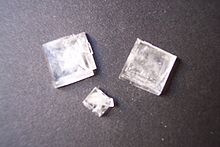A preservative is a substance or a chemical that is added to products such as food, beverages, pharmaceutical drugs, paints, biological samples, cosmetics, wood, and many other products to prevent decomposition by microbial growth or by undesirable chemical changes. In general, preservation is implemented in two modes, chemical and physical. Chemical preservation entails adding chemical compounds to the product. Physical preservation entails processes such as refrigeration or drying. Preservative food additives reduce the risk of foodborne infections, decrease microbial spoilage, and preserve fresh attributes and nutritional quality. Some physical techniques for food preservation include dehydration, UV-C radiation, freeze-drying, and refrigeration. Chemical preservation and physical preservation techniques are sometimes combined.

Citric acid is a weak organic acid that has the chemical formula C
6H
8O
7. It occurs naturally in citrus fruits. In biochemistry, it is an intermediate in the citric acid cycle, which occurs in the metabolism of all aerobic organisms.
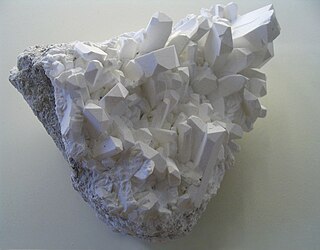
Borax, also known as sodium borate, sodium tetraborate, or disodium tetraborate, is an important boron compound, a mineral, and a salt of boric acid. Powdered borax is white, consisting of soft colorless crystals that dissolve in water. A number of closely related minerals or chemical compounds that differ in their crystal water content are referred to as borax, but the word is usually used to refer to the octahydrate. Commercially sold borax is partially dehydrated.

Butylated hydroxytoluene (BHT), also known as dibutylhydroxytoluene, is a lipophilic organic compound, chemically a derivative of phenol, that is useful for its antioxidant properties. European and U.S. regulations allow small amounts to be used as a food additive. In addition to this use, BHT is widely used to prevent oxidation in fluids and other materials where free radicals must be controlled.
A biocide is defined in the European legislation as a chemical substance or microorganism intended to destroy, deter, render harmless, or exert a controlling effect on any harmful organism by chemical or biological means. The US Environmental Protection Agency (EPA) uses a slightly different definition for biocides as "a diverse group of poisonous substances including preservatives, insecticides, disinfectants, and pesticides used for the control of organisms that are harmful to human or animal health or that cause damage to natural or manufactured products". When compared, the two definitions roughly imply the same, although the US EPA definition includes plant protection products and some veterinary medicines.
A colourant/colour additive or colorant/color additive is a substance that is added or applied in order to change the colour of a material or surface. Colourants can be used for many purposes including printing, painting, and for colouring many types of materials such as foods and plastics. Colourants work by absorbing varying amounts of light at different wavelengths of its spectrum, transmitting or reflecting the remaining light in straight lines or scattered.

Trisodium citrate has the chemical formula of Na3C6H5O7. It is sometimes referred to simply as "sodium citrate", though sodium citrate can refer to any of the three sodium salts of citric acid. It possesses a saline, mildly tart flavor. It is mildly basic and can be used along with citric acid to make biologically compatible buffers.
Plasticizers or dispersants are additives that increase the plasticity or decrease the viscosity of a material. These are the substances which are added in order to alter their physical properties. These are either liquids with low volatility or solids. They decrease the attraction between polymer chains to make them more flexible. Over the last 60 years more than 30,000 different substances have been evaluated for their plasticizing properties. Of these, only a small number – approximately 50 – are today in commercial use. The dominant applications are for plastics, especially polyvinyl chloride (PVC). The properties of other materials may also be modified when blended with plasticizers including concrete, clays, and related products. According to 2014 data, the total global market for plasticizers was 8.4 million metric tonnes including 1.3 million metric tonnes in Europe.
Acceptable daily intake or ADI is a measure of the amount of a specific substance in food or drinking water that can be ingested (orally) on a daily basis over a lifetime without an appreciable health risk. ADIs are expressed usually in milligrams per kilograms of body weight per day.
Biological assimilation, or bio-assimilation, is the combination of two processes to supply cells with nutrients. The first is the process of absorption of vitamins, minerals, and other chemicals from food within the gastrointestinal tract. In humans, this is always done with a chemical breakdown and physical breakdown. The second process of bio assimilation is the chemical alteration of substances in the bloodstream by the liver or cellular secretions. Although a few similar compounds can be absorbed in digestion bio assimilation, the bioavailability of many compounds is dictated by this second process since both the liver and cellular secretions can be very specific in their metabolic action. This second process is where the absorbed food reaches the cells via the liver.
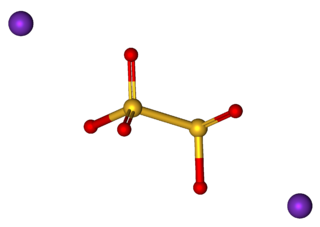
Potassium metabisulfite, K2S2O5, also known as potassium pyrosulfite, is a white crystalline powder with a pungent sulfur odour. The main use for the chemical is as an antioxidant or chemical sterilant. It is a disulfite and is chemically very similar to sodium metabisulfite, with which it is sometimes used interchangeably. Potassium metabisulfite is generally preferred out of the two as it does not contribute sodium to the diet.
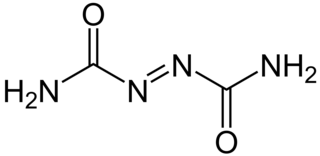
Azodicarbonamide, or azo(bis)formamide, is a chemical compound with the molecular formula C2H4O2N4. It is a yellow to orange-red, odorless, crystalline powder.
A packaging gas is used to pack sensitive materials such as food into a modified atmosphere environment. The gas used is usually inert, or of a nature that protects the integrity of the packaged goods, inhibiting unwanted chemical reactions such as food spoilage or oxidation. Some may also serve as a propellant for aerosol sprays like cans of whipped cream. For packaging food, the use of various gases is approved by regulatory organisations.

Propylparaben, the n-propyl ester of p-hydroxybenzoic acid, occurs as a natural substance found in many plants and some insects, although it is manufactured synthetically for use in cosmetics, pharmaceuticals and foods. It is a preservative typically found in many water-based cosmetics, such as creams, lotions, shampoos and bath products. As a food additive, it has the E number E216.
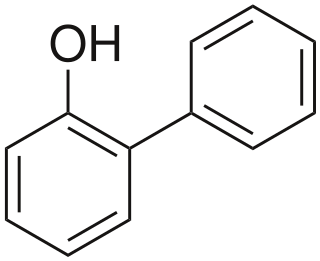
2-Phenylphenol, or o-phenylphenol, is an organic compound that consists of two linked benzene rings and a phenolic hydroxyl group. It is a white or buff-colored, flaky crystalline solid with a melting point of about 57 °C. It is a biocide used as a preservative with E number E231 and under the trade names Dowicide, Torsite, Fungal, Preventol, Nipacide and many others.

Ammonium ferric citrate has the formula (NH4)5[Fe(C6H4O7)2]. A distinguishing feature of this compound is that it is very soluble in water, in contrast to ferric citrate which is not very soluble.

Ferrous lactate, or iron(II) lactate, is a chemical compound consisting of one atom of iron (Fe2+) and two lactate anions. It has the chemical formula Fe(C3H5O3)2.

Cinnamyl acetate is a chemical compound of the cinnamyl ester family, in which the variable R group is substituted by a methyl group. As a result of the non-aromatic carbon-carbon double bond, cinnamyl acetate can exist in a Z and an E configuration:

